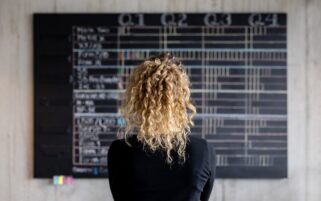A myriad of letters flow into GP practices every day, consuming a large part of the team’s time.
Dr Andrew Venning, a GP partner at Cricketfield Surgery in Devon, worked with his team to create a system that would help his practice save time on reviewing correspondence.
The new way of working was introduced just over a year ago and has since helped the practice save on average 25 hours per week of GP time, which roughly equates to 1,300 hours a year.
The problem
There are tons of letters that come into the practice on a daily basis; letters from district nurses, results, or letters from consultants asking us to change medications.
We would have 50-60 pieces of correspondence every day, just building up, and were completely swamped by them.
The solution
To solve this, we introduced a new way of processing our correspondence.
SystemOne, the software we use, has optical character recognition, which means it scans and reads the letter and then picks up key words.
Firstly, we programmed our software to look for certain terms and sort the letter into one category or another.
We decided to automate the process [of looking at correspondence] as much as we could and that took a long time as we had to programme the software to do that. However, once you’ve programmed it, you just need to keep updating it.
What we then realised was that, even if we had implemented some automation, looking into correspondence was still quite an onerous task. We also had variation in the way we worked as some GPs were mining every letter for every bit of information, whereas others were just looking for what they needed to do.
For this reason, we decided to create a protocol for the team to follow. We thought that some of our general administrators could look into the correspondence, rather than our medical personnel, and trained five members of the admin team to do this.
For a period of time, a GP met with them regularly to discuss different letters and we talked about which parts were important.
We then set some rules for them to adhere to. We worked with the GPs and administrators together, to negotiate what they felt was safe for the administrators to process without a GP.
We created some protocols, and the GPs and administrators together decided when certain information needed to be seen by a GP and when correspondence could be processed without having to be seen by a doctor.
Part of the quality assurance of our programme has been to keep training the team. This means that as the GP leading on the programme, I keep in contact with the team, acting as the link between the doctors and administrators and addressing queries from both sides.
The benefits
The programme has dramatically reduced the amount of letters and correspondence our GPs deal with. The letters GPs now receive have been partially processed, so the important parts are already highlighted for us.
For instance, we sometimes get a little note with the letter saying ‘please review the medication because there’s been a change’.
It just makes the whole process of reading a letter so much easier because we are able to look at it in a much more targeted way and spend less time worrying.
The system has certainly had an impact on patients’ safety, because more than one person is now looking at correspondence.
Letters that require no action from the GP don’t even get to us anymore, but the information they contain is moved straight into the patient’s records.
Correspondence that needs action from a clinician comes to us faster now and we are able to action it quickly as well.
We call the group managing this system ‘the workflow team’. Not everything needs to come to the most skilled person in the practice, so we introduced this more stratified approach where ‘low-level’ correspondence can be dealt with straight away.
The challenges
Introducing this new way of working was a team effort. As soon as we needed to get the administrative side of the practice involved, we collaborated with our practice manager, and she worked with the admin team in terms of what to do, and when and how to do it.
She helped us identify which members of the team could be released from their current responsibilities to look into the letters.
We trained five members of the admin team to do this, so that when someone is on holiday or off sick, we are covered. We looked for people who were a bit more skilled with medical terminology – who were already dealing with referrals.
The programme adds demand on our admin team. However, it has allowed some members of our team, who were keen to deal with clinical correspondence to receive training and further develop their interest in this.
We started this project in the summer 2017 and initially met every six weeks. Now we meet every two months.
We have had interest in this new way of working from two other practices. We are sharing our experience with other practices and definitely think this is a model that can be upscaled.
Dr Andrew Venning is a GP and partner at Cricketfield Surgery in Devon
Additional reporting by Valeria Fiore
This site is intended for health professionals only



